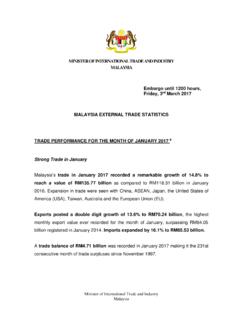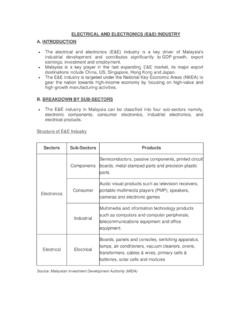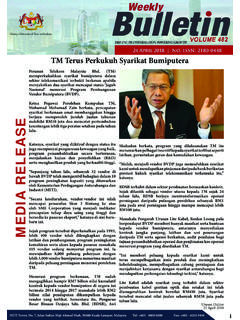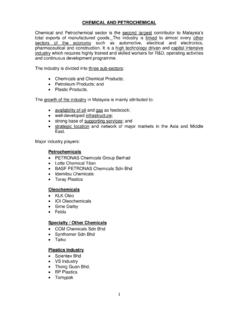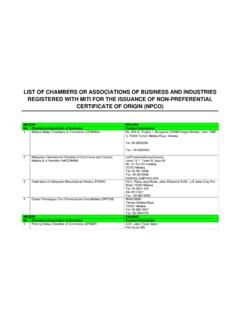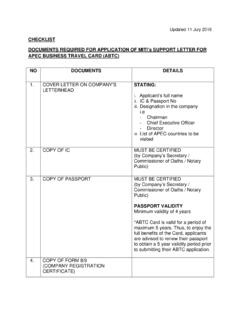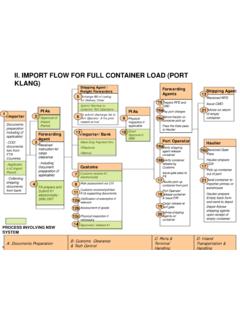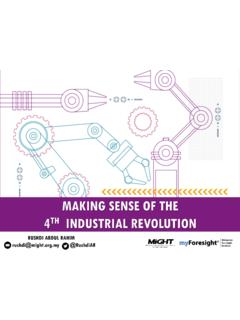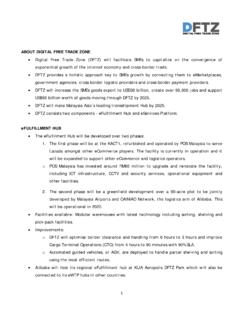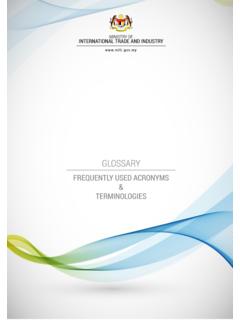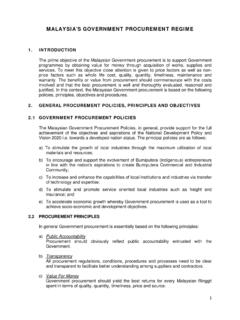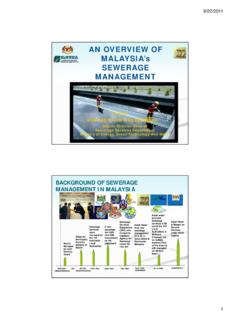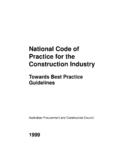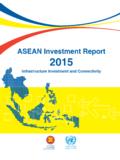Transcription of INTRODUCTION TO PREFERENTIAL CERTIFICATE …
1 Driving Transformation, Powering Growth MINISTRY OF INTERNATIONAL TRADE AND INDUSTRY INTRODUCTION TO PREFERENTIAL CERTIFICATE OF ORIGIN (PCO) MINISTRY OF INTERNATIONAL TRADE AND INDUSTRY Presentation Outline 2 OVERVIEW OF GLOBAL TRADE FREE TRADE AGREEMENTS (FTAs) RULES OF ORIGIN (ROO) HARMONISED SYSTEM OF TARIFF CLASSIFICATION (HS) ORIGIN CRITERIA DETERMINATION PREFERENTIAL CERTIFICATE OF ORIGIN (PCO) GENERALISED SYSTEM OF PREFERENCES (GSP) SELF CERTIFICATION SYSTEM UNDER ATIGA MINISTRY OF INTERNATIONAL TRADE AND INDUSTRY Overview of Global Trade 3 Malaysia, an open economy, with a small domestic market, needs to look beyond our borders for trade, investment and economic Driving Transformation, Powering Growth MINISTRY OF INTERNATIONAL TRADE AND INDUSTRY 4 Overview of Global Trade: The Importance of Trade Promoting economic growth for nations will small domestic market Consumers.
2 Better quality products and wider choice Enhancing productivity through sourcing from global value supply chain Promote FDI for trade and job creation Driving Transformation, Powering Growth MINISTRY OF INTERNATIONAL TRADE AND INDUSTRY 5 Overview of Global Trade: The Objectives of Global Trade Rules liberalise trade reduce barriers to trade seamless flow of goods and services Driving Transformation, Powering Growth MINISTRY OF INTERNATIONAL TRADE AND INDUSTRY 6 Free Trade Agreement (FTA) Driving Transformation, Powering Growth A legally binding, comprehensive agreement between two or more countries where member countries provide each other favorable treatments MINISTRY OF INTERNATIONAL TRADE AND INDUSTRY 7 Free Trade Agreement (FTA): Benefits of FTA Driving Transformation, Powering Growth Trade Improved Market Access.
3 Removal or reduced import duties; Relaxation or Removal of Non Tariff Barriers (NTBs); Trade Facilitation; and More choice of raw materials at a competitive price. Services Enhance cooperation in services amongst Member States: to improve the efficiency and competitiveness and supply and distribution of services of service suppliers within and outside Member States; Eliminate substantially restriction to trade in services amongst Member States; and Liberalise trade in services. Investment Increase investment; Investment protection: Increased predictability and increase transparency; and Investment liberalisation: Removal of equity restrictions and simplification of rules.
4 MINISTRY OF INTERNATIONAL TRADE AND INDUSTRY 8 Free Trade Agreement (FTA): Purposes of Trade in Goods Chapter in FTA Driving Transformation, Powering Growth Trade in Goods Chapter: Define the geographical area benefiting PREFERENTIAL market access Establish rules to determine whether goods eligible for PREFERENTIAL duty rates Define which tariff lines are eligible for PREFERENTIAL duty rates Set out tariff rate reduction or elimination schedule Prescribe approach to trade remedies Outline procedures for Customs MINISTRY OF INTERNATIONAL TRADE AND INDUSTRY 9 Free Trade Agreement (FTA): Malaysia s FTAs Involvement Driving Transformation, Powering Growth STATUS REGIONAL BILATERAL IMPLEMENTED 1) AFTA (ATIGA) (1992) 2) ASEAN-China (2004) 3) ASEAN-Rep.
5 Of Korea (2006) 4) ASEAN-Japan (2008) 5) ASEAN-India (2009) 6) ASEAN-Australia-New Zealand (2009) 1) Malaysia-Japan (2005) 2) Malaysia-Pakistan(2007) 3) Malaysia-New Zealand (2009) 4) Malaysia-Chile (2010) 5) Malaysia-India (2011) 6) Malaysia-Australia (2012) 7) Malaysia -Turkey (2015) TO BE IMPLEMENTED Trans-Pacific Partnership (TPP) Agreement (Note: On 4th February 2016, Malaysia signed the Trans-Pacific Partnership Agreement. Ratification is within 2 years of signing.) UNDER NEGOTIATIONS 1) ASEAN-Japan (Investment and Services) 2) Regional Comprehensive Economic Partnership (RCEP) ASEAN, China, Japan, Korea, India, Australia, New Zealand 3) ASEAN-Hong Kong (AHKFTA) 1) Malaysia-EU 2) Malaysia-EFTA (Iceland, Liechtenstein, Norway and Switzerland) MINISTRY OF INTERNATIONAL TRADE AND INDUSTRY The Importance of Rules of Origin (ROO) 10 Ensure that only FTA partners will benefit from the tariff concessions or PREFERENTIAL treatment.
6 To determine the country of origin of a product for purpose of international trade. Vary from different FTA agreements. Requirement for applying basic trade policy measures such as tariffs, quantitative restrictions, antidumping and countervailing duties and safeguard measures and etc. Driving Transformation, Powering Growth MINISTRY OF INTERNATIONAL TRADE AND INDUSTRY Types of Rules of Origin (ROO) 11 There are two (2) types of Rules of Origin (ROO). Non- PREFERENTIAL ROO: Used for non- PREFERENTIAL commercial policy instruments / purposes : application of MFN tariff; anti-dumping and countervailing duties; safeguard measures; origin marking and labeling, discriminatory Quantitative Restrictions (QR); Government procurement; trade statistics (WTO Agreement on ROO-Article 1 of the GATT 1994) PREFERENTIAL ROO: Determine whether a good qualifies for PREFERENTIAL treatment under a trading arrangement Bilateral FTA, Regional FTAs.
7 Autonomous trade regime (Developed Countries to Developing Countries- non-reciprocal) , Generalised system of Preference (GSP); Global System of Trade Preference (GSTP). Ensure benefits are limited to products originated from the contracting parties. Driving Transformation, Powering Growth MINISTRY OF INTERNATIONAL TRADE AND INDUSTRY Rules of Origin (ROO): Impact of ROO 12 Driving Transformation, Powering Growth More stringent ROO favours intermediate goods originating in the region to inputs from outside the FTA Parties - More trade diversion, less trade creation Less stringent ROO - Less industry protection, more access to cheaper inputs MINISTRY OF INTERNATIONAL TRADE AND INDUSTRY Harmonised System of Tariff Classification (HS) 13 Driving Transformation, Powering Growth Produced specific ROO are aligned to the World Customs Organization Harmonized System (HS) Nomenclature Code.
8 The HS systematically groups all traded goods into chapters, headings and subheadings that indicate, as concisely as possible, the categories and types of goods they cover. The HS organizes products according to the degree of production, and assigns them numbers known as tariff classifications. Within the HS there are 98 chapters, each of which is broken down into four digit headings identifying groups of goods MINISTRY OF INTERNATIONAL TRADE AND INDUSTRY Harmonised System of Tariff Classification (HS) 14 Driving Transformation, Powering Growth The headings are, in turn, broken down into subheadings, which are assigned six digits Companies are advised to refer to Royal Customs Malaysia Department (RMCD) on the accurate HS Code to be used for products meant to be exported.
9 MINISTRY OF INTERNATIONAL TRADE AND INDUSTRY Harmonised System of Tariff Classification (HS) 15 Driving Transformation, Powering Growth Example Chapter of apparel and clothing accessories, not knitted Heading garments and clothing accessories Subheading wool or fine animal hair MINISTRY OF INTERNATIONAL TRADE AND INDUSTRY Origin Criteria Determination 16 Driving Transformation, Powering Growth Wholly Obtained or Produced Where it only applies to the natural products agriculture products; live animals; mineral etc. Manufactured Substantial Transformation Value added (VA) method; Change in tariff classification (CTC); and Specified process of manufacture.
10 Originating Goods : Goods that meet the conditions for PREFERENTIAL market access. MINISTRY OF INTERNATIONAL TRADE AND INDUSTRY Origin Criteria Determination 17 Driving Transformation, Powering Growth Product Specific Rules (PSR) A list of tariff classification of interest with its intended ROO to be abided; and Not necessarily it covers all tariff lines. General Rule For Tariff Lines that do not fall under WO or PSR. MINISTRY OF INTERNATIONAL TRADE AND INDUSTRY Origin Criteria Determination: Substantial Transformation 18 Driving Transformation, Powering Growth A product has undergone sufficient working or processing and has been transformed into a new and different article.
